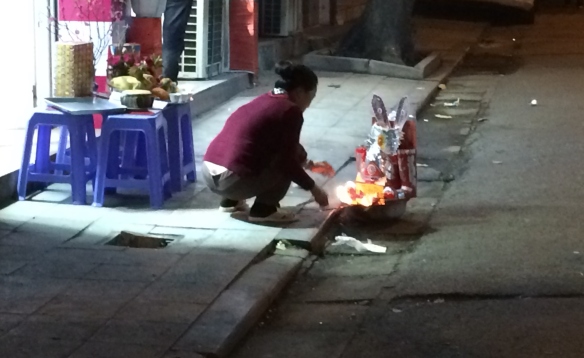
Têt, the days-long New Year celebration, is by far the most important holiday in Vietnam. Based on the Chinese lunar calendar, Têt falls on a different day each year. Preparations begin weeks in advance. Homes are first scoured to remove any bad luck from the previous year, then lavishly decorated with “good luck” colors of red and gold, bedecked with colorful flowers, miniature kumquat trees, and families begin to welcome home far-flung relatives as the majority of Vietnamese return to their ancestral homes for the holidays.


Têt can last for several days, beginning days or weeks ahead, with preparing traditional New Year foods, and ancestral altars are cleaned and refreshed with heaps of foods and gifts for the family’s ancestors. The emphasis on honoring one’s ancestors is an important ritual of Têt, especially for those who’ve passed away that year. The various offerings are meant for the departed to use on their journey to (hopefully) heaven.
We were honored by an invitation from our young guide, Quan, to join his family for a New Year Eve’s dinner at his apartment. “Happy,” as he liked to be called, was newly married with a 5 month old daughter. Like most young Vietnamese, he lived with his parents, an uncle and his grandfather in a Hanoi apartment building.

We brought a traditional gift of candies, as well as a large bottle of beer. (I’m still not sure if beer is a traditional Têt gift, but Happy said his grandfather liked beer at the holidays, so beer it was.) Happy introduced us to his wife, baby, and mother, who had been laboring in the kitchen preparing all the wonderful foods eaten at Têt.

Happy proudly showed us the family’s magnificent ancestral altar, laden with various Têt foods as well as gifts. We then sat on a straw mat with his family to partake of the modest feast his mother had prepared.

In addition to plain rice, we were served Vietnamese sausage, mung bean pudding, red sticky rice, Banh Chung, or steamed rice cake (shed of its banana leaf covering), and Western-style mini hot dogs (which although certainly not traditional, Happy specifically liked and asked for).
About halfway through the meal, Happy’s grandfather arrived, bowing and smiling in greeting before joining us on the mat. Grandfather Ca, in his eighties, formally introduced himself with Happy as his translator. After the introduction, the first thing he said was, “I am so happy our countries are friends again. War is a terrible thing, especially among friends, but now our countries are at peace. This makes me glad.”
I knew from what Happy had told us that his grandfather, now in his late eighties, had been in the North Vietnamese Army, and admired Ho Chi Minh (whose bust was on the family altar) but Happy said Grandfather Ca had always wanted Vietnam and America to be on peaceful terms. And this despite an awful, bloody war which saw, among other deeds (on both sides) massive U.S. bombings of swathes of Hanoi and other sections of then North Vietnam. Grandfather Ca ended his speech by giving me (because I had lived in pre-war Vietnam) a specially printed Têt card inscribed with a poem he’d written, and good luck wishes for the coming year. Happy explained that Ca and his friends would write these special poems and greetings every year to exchange among themselves and to give to family members and close friends. We felt quite honored.
We left after dinner for a short nap before making our way to the central lake in Hanoi to watch the fireworks that would usher in the New Year at midnight.We were intrigued by many of the altars set up on the sidewalks or roadways in front of shops to honor the shopkeepers’ ancestors. All had similar foods and gifts as had Happy’s family altar, but with the addition of a whole boiled chicken — head, cockle, beak and all — a special offering to the ancestors.

Due to my dawdling over these fascinating altars, we never made it to Hoan Kiem Lake where the fireworks were held. Caught at midnight in the streets with dozens of others, we gazed from a couple of blocks away at the fireworks as they exploded over the rooftops. The Vietnamese love fireworks, but at Têt they have a special function, to ward off any evil spirits as the new year begins. Children ran about, setting off long tubes of small fireworks and whirling noisemakers, making as much noise and bangs as possible to scare off the evil spirits. It was quite a display.

Returning to our hotel, we saw many people carefully burning their paper offerings that had earlier sat on their altars. Symbolic gifts are made of paper, such as (fake) money, cars, miniature houses, floral bouquets and wrapped (empty) boxes, to be burned as the new year begins to speed these offerings to their ancestors.
I’m not sure what is done with the chicken.
But I can definitely say that this Têt celebration in Hanoi was one of the most memorable celebrations I can remember.
Têt in 2016 in Vietnam will begin February 8.
Chuc Mung Nam Moi!
![]()

Carol Barbier Rolnick grew up in Japan and Southeast Asia, traveling extensively as a child through Asia, the Mideast and Europe on family vacations. Travel has continued as a priority through raising kids and continuing into retirement, extending adventures through the Americas, southern Africa, Asia, and repeat trips throughout Europe. Carol and her husband, Michael spent four summers based in Utrecht, The Netherlands, which has become like a second home. They are (still) aiming towards Australia-New Zealand and Antarctica to round off their continental travels.








